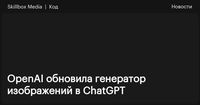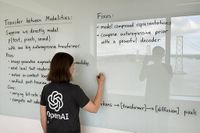OpenAI has recently released a significant update to its ChatGPT platform, introducing new image generation and editing capabilities that have sparked considerable interest among users. This update allows users to create images directly within ChatGPT, eliminating the need to switch to the previously integrated DALL-E AI model.
The new image generation system is powered by the advanced GPT-4o multimodal model, enabling users to create images based on text descriptions. This includes a variety of styles, such as photorealistic images, illustrations, and concept art. Notably, the improved generator can handle up to 20 different objects simultaneously while maintaining the correct relationships between them. This feature is particularly beneficial for users looking to create infographics or logos.
In addition to generating images from scratch, the updated system also allows users to edit existing images. Users can upload their own images and make modifications, such as changing the background, adding objects, or applying various stylistic changes. Unlike the DALL-E model, which had a strict moderation system, the new generator offers users greater creative freedom, even permitting the creation of potentially offensive content within reasonable limits.
Despite the enthusiasm surrounding these new features, the overwhelming demand for image generation has led OpenAI to temporarily disable this functionality for users of the free version of ChatGPT. On March 27, 2025, OpenAI CEO Sam Altman announced via the social media platform X that the company was forced to limit the frequency of image generation requests due to server overload. "It's very fun to watch how people like images in ChatGPT, but our graphics processors are melting," Altman remarked, highlighting the technical challenges posed by the surge in user interest.
Although Altman did not specify the exact limits imposed, he expressed hope that these restrictions would not be necessary for long as OpenAI works to enhance the efficiency of its processing capabilities. Meanwhile, ChatGPT Plus subscribers and corporate clients can still generate images without restrictions, although a timeline for when the feature will be restored to free users has not yet been disclosed.
OpenAI's update is already accessible in the web version of ChatGPT, as well as in mobile applications for iOS and Android. The company is also launching OpenAI Academy, a free online platform designed to improve AI literacy among a broad audience. This initiative provides lectures, workshops, and discussions tailored for individuals at various skill levels, from beginners to experienced developers.
The educational content available on OpenAI Academy spans a wide range of topics, covering everything from the basics of artificial intelligence to advanced integration methods. Users can engage with the material through live broadcasts and video resources, which facilitate interactive learning, as well as in-person events that offer practical training and networking opportunities with industry experts.
The launch of the OpenAI Academy reflects the company's commitment to fostering a deeper understanding of AI technologies among the general public. By providing accessible educational resources, OpenAI aims to empower individuals to navigate the complexities of AI and its applications in various fields.
As the demand for AI-generated content continues to rise, OpenAI's developments in image generation and educational initiatives position it at the forefront of the AI landscape. The company is navigating the challenges of scalability while also striving to democratize access to AI knowledge and tools.
In summary, OpenAI's latest updates to ChatGPT and the introduction of OpenAI Academy signify a pivotal moment in the evolution of AI technology. As users eagerly embrace the new capabilities, the company faces the challenge of balancing demand with the need for sustainable infrastructure. The future of AI-generated content looks promising, but it will require ongoing innovation and adaptation to meet the needs of a growing user base.


